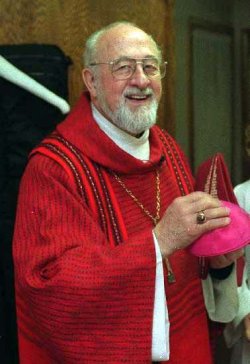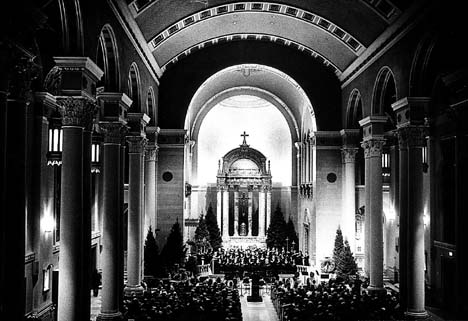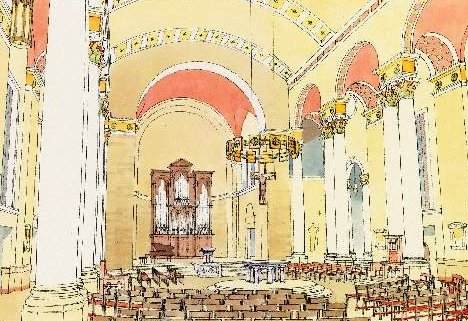

Weakland's Cathedral Renovations

Modern iconoclasts continue turning artistic treasures into pagan atrocities
Last week, Archbishop Rembert G. Weakland began a $4.5 million renovation of the Cathedral of St. John the Evangelist. Despite numerous and repeated protests from thousands of local Catholics and formal instruction from the Vatican to halt the renovation plans, workers began dismantling the high altar and crushing the surrounding marble columns.
Cardinal Jorge Medina ordered Weakland to stop the destruction of the cathedral and resubmit plans that are more in line with liturgical and canonical norms. Weakland said he considered the points raised by Cardinal Medina but saw no issues that required any change of plans. It is heartening to know that Archbishop Weakland's modernist ability to ignore opposing statements is so well developed. Medina wrote:
"...it would seem to this congregation that the ancient and venerable high altar together with its baldacchino should be retained, given also that it is a most suitable location for the reservation of the Most Blessed Sacrament."
Weakland's response was to promptly remove the baldacchino and crush the marble pillars that supported it. In a letter to his priests, he justified his actions by stating:
"We are not a corporation with head offices in Rome ... it is my obligation to insist on the rights and duties of the local bishop in the Catholic Church"
We won't get into (yet) the defiance of American Bishops that has lead to "altar girls" and extraordinary ministers, and the subsequent concessions of the Vatican encouraging the behavior. That's a whole other issue.
Vosko's Cathedral Renovations
When planning the cathedral renovation, the Archdiocese of Milwaukee employed the services of liturgical design consultant Fr. Richard Vosko. Vosko, a new-age priest out of Albany, has been on "special assignment" since 1970 renovating (many say "ruining") Catholic churches throughout the country. He was instrumental in the renovations of Seattle's St. James Cathedral, which bears the scars of combining liberal theology with poor planning. An article in U.S. Catholic, describes part of the redesign process:
Early in the process some 300 parishioners were gathered at tables, given sheets showing an outline of the church, and asked to draw exactly where they thought the altar, baptistery, tabernacle, and other furniture should be positioned.
Never mind the long history of Church liturgical architecture, entrenched in Catholic doctrine, which has produced some the greatest structural accomplishments known to man. Let's give a bunch of laypeople some crayons to see what kind of Church would make them feel more spiritual. What was the result? A high altar replaced with an organ, deck chairs encircling a central altar and the Blessed Sacrament relocated into a cage (appropriately enough) with enough space for only six kneelers.
New churches and cathedrals are even worse. Without even the structural boundaries of a traditional Church, we're now seeing pentagons, squares, circles and other shapes reminiscent of pagan temples. And once one gets inside, gone are statues of saints and images and biblical events. In their place, we see strange shapes and abstract structures. Take a look at Seattle University's new chapel for an example of mixing modern "art" with the Catholic Faith (http://www.seattleu.edu/chapel). In Los Angeles, Cardinal Roger Mahony, who is always looking for new ways to lay waste to the Church, is spending over a hundred million dollars to build a new cathedral that will never be mistaken for a Catholic church (or at least one can hope).
 Milwaukee Cathedral Before |
 Milwaukee Cathedral After |
New Structures for a New Church
What is behind the recent efforts to renovate existing churches and cathedrals? Even pagans recognize the shame in destroying classic works of art, replacing them with banal meeting halls. As in Milwaukee, Catholics accept most of the changes because bishops and priests claim they were mandated by Vatican II. As anyone with even a rudimentary understanding of canon law and the Second Vatican Council knows, this is complete nonsense. Archbishop Weakland was repeatedly called upon to justify this claim and was finally rebuked by Rome. Not only were the changes not mandated, but they were opposed to liturgical guidelines and norms.
The simple fact is, these renovations to reflect a new attitude (but old heresy) towards the Church and its Mass. Churches are made to accommodate the errors implied in a new Mass which has reduced a Holy Sacrifice to a performance on a stage. The focus has shifted from the sacramental Christ to the priest and the congregation as they celebrate their spirituality and assert themselves. In this new worship of man, the focal point of the Church and the Mass, the Blessed Sacrament, is relegated from a central position of prominence to a separate room or chapel, as if it were a relic of an antiquated Church. We are witnessing just another result of the continuous break from tradition which is seen theology, ecumenical efforts, social policies and discipline. Those who are indoctrinated with the masonic and American ideals of improvement by human standards cannot accept an unchanging Faith unaffected by the popular ideas of man. However horribly they may mutilate the appearances of the Faith, the divine institution of the Catholic Church will not be brought down by dissidence or heresy, even from within its ranks.
Peter Miller
Seattle, WA
7/27/2001

